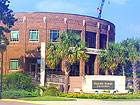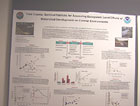

 | |||||||||||||||
|
|
Journals 2005/2006Sarah Mitchell
June 29, 2005 My name is Sarah Mitchell, and I am an 8th grade science teacher at a public school in Bradenton, Florida. I am currently in Charleston, South Carolina where I am about to begin a two-week experience at Hollings Marine Laboratory. With nine years of teaching behind me, I have come to enjoy participating in summer teacher experience programs, and this year I was fortunate enough to have been selected to participate in the ARMADA Project. I arrived at Hollings Marine Lab early this morning and was met by Susan Lovelace, the education coordinator for the Oceans and Human Health Initiative (OHHI). Susan's job includes developing communication networks to help transfer the information generated by the program. Included in those to receive this information are students of all ages. Seeing the natural link to the ARMADA objectives, Susan contacted them and expressed an interest in having a teacher participate in OHHI. So, here I am. Today I was given a general overview of the lab and the OHHI program. As one of NOAA's centers for the Human Health Initiative, the staff at Hollings is working on new methods to identify chemical and microbial threats to both marine ecosystems and human health. Three core research areas help them with this goal. They are environmental chemistry, pathogen source tracking and marine genomic. One of the first things that impressed me about the facility is that it is run as a partnership with NOAA, the South Carolina Department of Natural resources (DNR), the National Institute of Standards and Technology (NIST), the Medical University of South Carolina and the College of Charleston. The focus of the OHH program is to better understand the connection between environmental conditions along our coasts to human health and socio-economic well-being. The research addresses the following questions: What are the cumulative impacts of coastal development on our marine biota and humans? Are the fish and shellfish safe to eat? Is it safe to swim in the oceans? What can be done to reduce these problems?
The first stop was with Laura Webster who works on pathogen source tracking. Using some of the latest technology, Laura helps to detect and track marine microbes that are a concern in regards to public health. These include bacteria, viruses, parasites and harmful algal bloom species. While many microbes are indigenous to the oceans, others are introduced via surface runoff, wastewater discharge and storm water drains. Through the use of DNA tracking, the sources of these microbes can often be identified which will hopefully lead to strategies to help reduce such contamination. The next stop was with Ed Wirth who works in Environmental Chemistry. In addition to looking at the historically identified harmful elements like PCB's, DDT and mercury, Ed works on identifying new emerging chemicals of concern. These include things like the chemical PBDE used in flame retardants, various pharmaceuticals, lipid regulators and antibiotics. The objective is to develop methods to detect and then quantify these contaminants. After a brief overview of his part in this program, Ed gave me a tour of the labs where they use state of the art technology to separate and isolate the particles they are trying to detect. Equipment here included chromatographers and spectrometers. A look at seafood health and safety was my next stop, where I met with John Lefler. John explained the job of determining the balance between the benefits and risks of eating fish. While fish are known to have a variety of health benefits, as levels of contamination increase, these risks must be weighed into our decisions. At this time their studies are focusing on red drum and shrimp. They are also looking at the benefits and risks associated with fish farming which includes looking at the environmental as well as economical issues. Data Management systems was introduced to me by David White. This group works on helping to display the data collected in an informative way. Lining the halls of the laboratory are many of the posters that explain the various projects going on here. I always wish my students could see these to help understand why posters are so important at science fairs.
My final stop was with Paul Gross who works with the applied marine genomic group. Using state of the art robots, the genomics team is able to isolate and replicate DNA and proteins to try to determine effects of various environmental factors on them. Each species has its own unique DNA, but if I understood this correctly many of the genes are not really "turned on". Understanding this will help answer many questions. |
||||||||||||||


